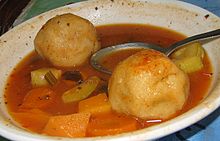
Back مطبخ يهود مزراحي Arabic مطبخ يهود مزراحى ARZ Gastronomía sefardí Spanish Hidangan Yahudi Mizrahi ID Olahan Mizrahi Yahudi JV Lutuing Sefardi Tagalog

Mizrahi Jewish cuisine is an assortment of cooking traditions that developed among the Mizrahi Jewish communities of the Middle East, North Africa and Central Asia. Influenced by the diverse local culinary practices of countries such as Morocco, Libya, Egypt, Iraq, Iran, Yemen, and Syria, Mizrahi cuisine prominently features rice, legumes, meats (especially lamb and chicken), and an array of spices such as cumin, turmeric, and coriander. Signature dishes include kubbeh (dumplings), pilafs, grilled meats, and stews like hamin.
Jews of the Mizrahi communities cook foods that were and are popular in their host countries, while following the laws of kashrut. Many dishes are brought in from their host countries and/or altered to varying degrees. While some political activists maintain that this is appropriation, in the case of for example hummus, for Mizrahi Jews it is more a reflection of honor and remembrance. The cuisine is based largely on fresh ingredients, as marketing was done in the local souq.
Meat is ritually slaughtered in the shechita process, and is soaked and salted. Meat dishes are a prominent feature of Shabbat, festival, and celebratory meals. Cooked, stuffed and baked vegetables are central to the cuisine, as are various kinds of beans, chickpeas, lentils and burghul (cracked wheat). Rice takes the place of potatoes.